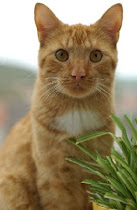Feline HyperthyroidismThursday, January 20 by Dr. Sarah from Lifes Abundance
Since the late 1970’s, there has been a significant increase in the prevalence of feline hyperthyroidism, making it the most common feline endocrine disorder in the world. What causes hyperthyroidism, and why is it so common? Previous studies of cats in the U.S., Great Britain and New Zealand have identified a number of risk factors for the development of hyperthyroidism, including genetic predispositions, the feeding of some canned cat foods and cross-breeding. Furthermore, some veterinarians believe feline hyperthyroidism is simply an outcome of cats living longer. But, if thyroid dysfunction is symptomatic of old age, why is it not more common in dogs, or people for that matter?
Veterinarians first noticed a dramatic surge in feline hyperthyroidism in the 1980’s. This rise coincided with the prevalent use of PBDE’s as a flame retardant in many products. A chemical flame retardant used widely in carpet pads, furniture, and electronics, PBDE (or, polybrominated dephenyl ethers) were researched in a recent EPA study that suggested that these chemicals may partly explain the current epidemic. PBDE’s linger in the environment, and cats ingest the substance in both foods and by licking their fur which retains house dust laced with toxic PBDE particles. Furthermore, studies have also shown a link between hyperthyroidism and BPA in the lining of many canned cat foods. Life’s Abundance is proud to inform our consumers that the lining in our canned foods is BPA-free.
An Environmental Science & Technology study reported in 2007 looked at whether hyperthyroid cats had greater body burdens of PBDE’s, and found that all cats have high levels compared to humans, with some cats with incredibly high levels (Dye et. al, 2007). The potential link between feline hyperthyroidism and PBDE exposure may be the veritable “canary in the coal mine” when it comes to evaluating the human health impacts of PBDE’s. People in the United States have the highest PBDE levels reported worldwide, according to a 2004 study also published in Environmental Science & Technology. By gaining a more complete understanding of chronic indoor PBDE exposure and its effects on thyroid hormone levels in cats, medical researchers can better assess whether the same risk exists for people. Researchers believe that further studies need to be performed before concluding a direct link between PBDE’s and feline hyperthyroidism.
There is good news, however. It isn’t necessary to rip up your carpet and throw out your furniture as these chemicals have been or are in the process of being banned in many states. And cats still live longer, healthier lives if they live primarily indoors, and the risk of being attacked by other animals or hit by a car while roaming outside is still much greater than the risk of developing hyperthyroidism from PBDE exposure.
What can you do if your cat has already been diagnosed with hyperthyroidism? What are the symptoms? In this video, Dr. Sarah reviews the signs of hyperthyroidism and treatments available. If you suspect your kitty has hyperthyroidism, schedule an appointment with your local veterinarian.
Potera, C. Environews Forum. Chemical Exposure: Cats as Sentinel Species. Environ Health Perspect. 2007. Dec;115(12)A580.
Wakeling J, Everard A, Brodbelt D, Elliott J, Syme H. Risk factors for feline hyperthyroidism in the UK. J Small Anim Pract. 2009 Aug;50(8):406-14.
###
Today's Post sponsor: A healthy, wholesome cat food will help your cat liver a longer, happier life. Check out Lifes Abundance Cat Food and compare your current brand with Lifes Abundance Pet Food.
***
Saturday, January 22, 2011
Feline Hyperthyroidism
Labels:
dr. sarah,
feline hyperthyroidism
Subscribe to:
Post Comments (Atom)

Hi! My cat has been diagnosed with hyperthyroidism this week and I would love to switch to Lifes Abundance Cat Food. I live in Belgium (Europe) though. Is it available in this country? And if yes, can you send me the names and addresses of a few shops there that sell Lifes Abundance Cat Food (preferably, but not necessarily, in or around Brussels)? You may contact me through my blog. Thank you so much for your help.
ReplyDeleteUnfortunately, Lifes Abundance Cat Food is only sold in the United States thru independent distributors. It's sold online so that the food is always shipped fresh to your door.
ReplyDeleteA link of where to purchase online in the US is http://www.bestfurryfriend.com